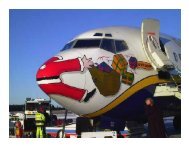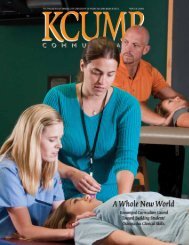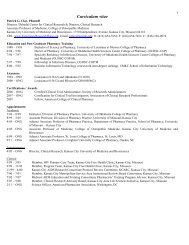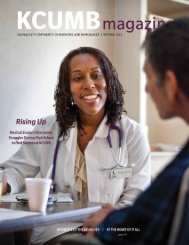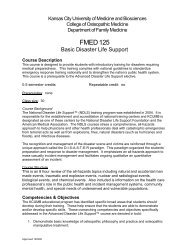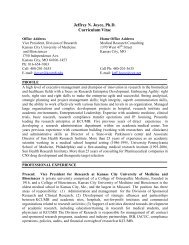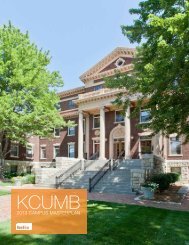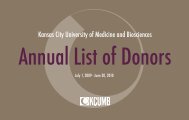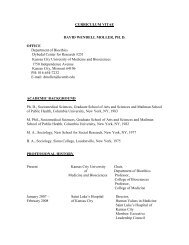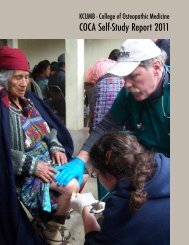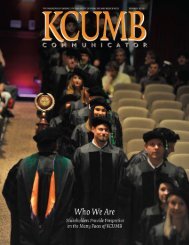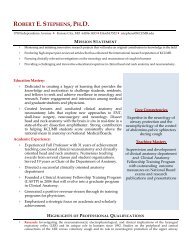news - Kansas City University of Medicine and Biosciences
news - Kansas City University of Medicine and Biosciences
news - Kansas City University of Medicine and Biosciences
- No tags were found...
Create successful ePaper yourself
Turn your PDF publications into a flip-book with our unique Google optimized e-Paper software.
An Everlasting GiftKCUMB’s Gift Body Program Plays an Integral Rolein the Education <strong>of</strong> Future PhysiciansStory by Christopher RyanIllustration by Rachel MindrupHer name was Mabyn, <strong>and</strong> she was born to hardworking<strong>Kansas</strong> dairy farmers in Valley Center,Kan., between the two world wars. She earned adegree in home economics from <strong>Kansas</strong> State <strong>University</strong>. In1944, she married Ken Makalous, a county extension agent.Not long after they married, Mabyn <strong>and</strong> Ken settled down toraise poultry in Marshall County, Kan. A strong believer ineducation, Mabyn also taught school. She <strong>and</strong> Ken had twochildren, both boys.In 1952, Ken contracted polio <strong>and</strong> lost the use <strong>of</strong> hislegs. Mabyn kept on raising poultry, carrying the 50-poundfeedbags <strong>and</strong> tending to the family business until she <strong>and</strong>her husb<strong>and</strong> retired in 1966.Ken died in 1991. Mabyn passed away in 2008. ButMabyn’s commitment to work <strong>and</strong> education did not endwith her death.Years before, when Ken was alive, he mentioned thathe would like to donate his body for medical education.Circumstances prevented his family from fulfilling thatwish, but Mabyn still took it to heart. She decided to honorher husb<strong>and</strong>’s wishes by donating her own body throughthe Gift Body Program at <strong>Kansas</strong> <strong>City</strong> <strong>University</strong> <strong>of</strong> <strong>Medicine</strong><strong>and</strong> <strong>Biosciences</strong>.Well before Mabyn’s death, she <strong>and</strong> her son, Ray, met<strong>and</strong> worked with Pam Thomas, Ph.D., associate pr<strong>of</strong>essor<strong>of</strong> anatomy <strong>and</strong> Gift Body Program coordinator, to make thearrangements. There were questions <strong>and</strong> paperwork but,most important, there was empathy.“I was with my mom the evening she passed away,”Ray said. “I was holding her h<strong>and</strong>. We knew what had to bedone as far as who neededto be called <strong>and</strong> all that,<strong>and</strong> I think what reallymade it so comforting wasthat we knew Dr. PamThomas would be involvedin the whole thing, oncethe body arrived there.”A “Non-Ending Gift”Dr. Thomas hasled KCUMB’s Gift BodyProgram for 18 years. She<strong>and</strong> Felicia Harris, theprogram’s administrativeassistant, share responsibilityfor serving as liaisonwith donors <strong>and</strong> theirfamilies. It is work theyboth find fulfilling.For Harris, helping donors <strong>and</strong> their families is the bestpart <strong>of</strong> her job.“I tend to believe that I’m a people person,” she said. “Ibelieve in the program. I do really enjoy the interaction, <strong>and</strong>it is rewarding when you get the feedback from the family.”The feedback Dr. Thomas <strong>and</strong> Harris receive is overwhelminglypositive, most <strong>of</strong> it along the lines <strong>of</strong> RayMakalous’s endorsement. Dr. Thomas suggests that thereason for the good will has to do with the attitude <strong>of</strong> the donors,their families, the osteopathic medical students <strong>and</strong> theprogram staff, as well as the Gift Body Program’s structure.A donated body is “a non-ending gift,” Dr. Thomassaid. It benefits not only the students who learn from it,but also the patients those students will treat during theircareer. People who donate their bodies underst<strong>and</strong> this.Often, donors have some connection to education. Theymight be teachers, including current <strong>and</strong> retired staff atKCUMB. Dr. Thomas believes these people want to continueto teach even after their lives are over.Another prominent group <strong>of</strong> donors consists <strong>of</strong> farmers,perhaps because they know about the cycle <strong>of</strong> life <strong>and</strong>appreciate its complexity <strong>and</strong> beauty. However, donors comefrom all walks <strong>of</strong> life.Of course, it is the students who are the initial beneficiaries<strong>of</strong> donors’ generosity, <strong>and</strong> at KCUMB, they are taughtfrom the beginning how valuable <strong>and</strong> worthy <strong>of</strong> respect thedonors are. The lesson begins even before the students meettheir gift bodies. They attend a class on death <strong>and</strong> dying,which Dr. Thomas co-teaches.Dr. Thomas asks her students to write a letter to thedonor. This exercise gives thestudents a chance to voice theirown fears <strong>and</strong> worries aboutwhat they will have to do inthe gross anatomy lab. Theletters are read or posted at adonor memorial service where“Continued on page 10There are things you justcan’t depict in a picture,like a layer <strong>of</strong> tissue inthe abdomen. It’s likenothing else.Pam Thomas, Ph.D.”8 Summer 2012 KCUMB CommunicatorSummer 2012 KCUMB Communicator 9



